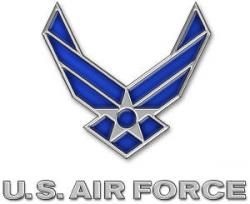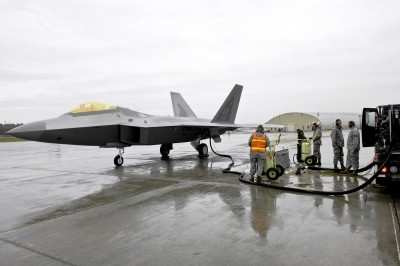Mon, Sep 07, 2009
Air Force Hopes Additive Will Reduce Engine Maintenance
 Elmendorf Air Force Base officials started to blend a
thermally stable additive known as Plus 100 to its JP-8 aviation
fuel Sept. 1. The additive prevents coking and carbon buildup in
the engine, which will greatly reduce engine maintenance. Even
before base officials began using this additive, the 3rd Logistics
Readiness Squadron's Fuels Management Flight team was always ready
to provide gas, 24 hours a day, seven days a week. The Airmen
refuel all aircraft assigned here and any passing through day or
night. On average, the team refuels 60 aircraft a day.
Elmendorf Air Force Base officials started to blend a
thermally stable additive known as Plus 100 to its JP-8 aviation
fuel Sept. 1. The additive prevents coking and carbon buildup in
the engine, which will greatly reduce engine maintenance. Even
before base officials began using this additive, the 3rd Logistics
Readiness Squadron's Fuels Management Flight team was always ready
to provide gas, 24 hours a day, seven days a week. The Airmen
refuel all aircraft assigned here and any passing through day or
night. On average, the team refuels 60 aircraft a day.
Fuel pumped to aircraft goes through an inspection. "The fuels
laboratory is responsible for ensuring all fuel that moves on
Elmendorf meets stringent Air Force standards," said Master Sgt.
Eugene Cataldi, the NCO in charge for the fuels information service
center. The presence of water and particles are just some of the
things the flight members look for. "Aircrew safety is our biggest
priority," Sergeant Cataldi said. "Lives are on the line. If fuel
doesn't meet specifications, it could result in catastrophic
consequences." The filter separator elements on refuel trucks and
dispensing equipment are changed out ever three years. Sergeant
Cataldi said it doesn't matter if the part was used once or 20
times. His team must be sure only clean, dry fuel is issued to the
aircraft.

USAF Photo
After the fuel is checked and meets Air Force standards, it's up
to the truck drivers to get it out on the flightline and fill the
aircraft. "We have 20 plus drivers in the flight and we do multiple
types of refuels," said Tech. Sgt. Karl Andrescavage, the fuels
distribution supervisor for the fuels management flight. The hot
pit refuels is one of the refueling methods used, which is common
in deployed environments. The aircraft rolls up, without shutting
down engines, to a spot where a team is ready to refuel it. After
the aircraft is fueled, it takes off. Sergeant Andrescavage said
it's only a matter of about 10 minutes to refuel the aircraft and
have it back in the air.
ANN Salutes Airman 1st Class Christopher Gross 3rd Wing Public
Affairs
More News
Takeoff Roll The process whereby an aircraft is aligned with the runway centerline and the aircraft is moving with the intent to take off. For helicopters, this pertains to the act>[...]
“We’re proud of the hard work that went into receiving this validation, and it will be a welcome relief to our customers in the European Union. We couldn’t be mor>[...]
"Aircraft Spruce is pleased to announce the acquisition of the parts distribution operations of Wag-Aero. Wag-Aero was founded in the 1960’s by Dick and Bobbie Wagner in the >[...]
IDENT Feature The special feature in the Air Traffic Control Radar Beacon System (ATCRBS) equipment. It is used to immediately distinguish one displayed beacon target from other be>[...]
Aero Linx: Pararescue Air Force Pararescuemen, also known as PJs, are the only DoD elite combat forces specifically organized, trained, equipped, and postured to conduct full spect>[...]
 ANN's Daily Aero-Term (05.10.24): Takeoff Roll
ANN's Daily Aero-Term (05.10.24): Takeoff Roll Aero-News: Quote of the Day (05.10.24)
Aero-News: Quote of the Day (05.10.24) Aero-News: Quote of the Day (05.11.24)
Aero-News: Quote of the Day (05.11.24) ANN's Daily Aero-Term (05.11.24): IDENT Feature
ANN's Daily Aero-Term (05.11.24): IDENT Feature ANN's Daily Aero-Linx (05.11.24)
ANN's Daily Aero-Linx (05.11.24)




